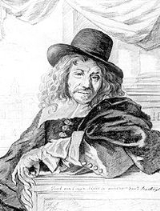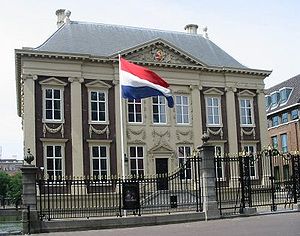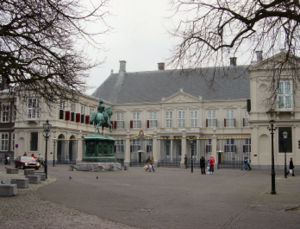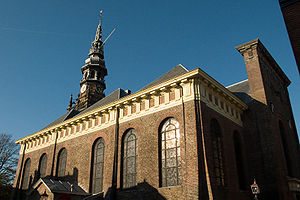
Jacob van Campen
Encyclopedia



Netherlands
The Netherlands is a constituent country of the Kingdom of the Netherlands, located mainly in North-West Europe and with several islands in the Caribbean. Mainland Netherlands borders the North Sea to the north and west, Belgium to the south, and Germany to the east, and shares maritime borders...
artist and architect of the Golden Age
Dutch Golden Age
The Golden Age was a period in Dutch history, roughly spanning the 17th century, in which Dutch trade, science, military and art were among the most acclaimed in the world. The first half is characterised by the Eighty Years' War till 1648...
.
Life
He was born into a wealthy family at HaarlemHaarlem
Haarlem is a municipality and a city in the Netherlands. It is the capital of the province of North Holland, the northern half of Holland, which at one time was the most powerful of the seven provinces of the Dutch Republic...
, and spent his youth in his home town. Being of noble birth and with time on his hands, he took up painting mainly as a pastime. In 1614, he became a member of the Guild of Saint Luke
Guild of Saint Luke
The Guild of Saint Luke was the most common name for a city guild for painters and other artists in early modern Europe, especially in the Low Countries. They were named in honor of the Evangelist Luke, the patron saint of artists, who was identified by John of Damascus as having painted the...
(in Haarlem the architects and painters were both in the same guild, and many were both, such as Pieter Saenredam and Salomon de Bray
Salomon de Bray
Salomon de Bray was a Dutch Golden Age architect and painter.-Biography:De Bray was born inAmsterdam, but established himself in Haarlem before 1617, where he is registered as being a member of the schutterij that year in the St. Adrian's cloveniers...
), and studied painting under Frans de Grebber - a number of Van Campen's oils survive. About 1616 to 1624 he is thought to have lived in Italy. On his return to the Netherlands, Van Campen turned to architecture, applying ideas borrowed from Andrea Palladio
Andrea Palladio
Andrea Palladio was an architect active in the Republic of Venice. Palladio, influenced by Roman and Greek architecture, primarily by Vitruvius, is widely considered the most influential individual in the history of Western architecture...
, Vincenzo Scamozzi
Vincenzo Scamozzi
thumb|250px|Portrait of Vincenzo Scamozzi by [[Paolo Veronese]]Vincenzo Scamozzi was a Venetian architect and a writer on architecture, active mainly in Vicenza and Republic of Venice area in the second half of the 16th century...
and classical influences from Vitruvius. He was primarily responsible for introducing the classical revival style
Neoclassical architecture
Neoclassical architecture was an architectural style produced by the neoclassical movement that began in the mid-18th century, manifested both in its details as a reaction against the Rococo style of naturalistic ornament, and in its architectural formulas as an outgrowth of some classicizing...
into Dutch Baroque architecture, combining the native, Dutch brick style with the Vitruvian principles he had learnt to produce "Dutch Classicism", an internationally influential style.
Van Campen was friendly with Constantijn Huygens
Constantijn Huygens
Constantijn Huygens , was a Dutch Golden Age poet and composer. He was secretary to two Princes of Orange: Frederick Henry and William II, and the father of the scientist Christiaan Huygens.-Biography:...
, and together they designed a new house for Huygens. Even after Van Campen's death, his work greatly influenced Johan Maurits van Nassau-Siegen, the designer of the Kleefse gardens (the gardens of Cleve
Kleve
Kleve , is a town in the Lower Rhine region of northwestern Germany near the Dutch border and the River Rhine. From the 11th century onwards, Kleve was capital of a county and later a duchy...
), and on Frederick William, Elector of Brandenburg
Frederick William, Elector of Brandenburg
|align=right|Frederick William was Elector of Brandenburg and Duke of Prussia – and thus ruler of Brandenburg-Prussia – from 1640 until his death. A member of the House of Hohenzollern, he is popularly known as the "Great Elector" because of his military and political prowess...
. The latter to own a book by Van Campen regardless of the expense. The city hall and the city palace of Potsdam
Potsdam
Potsdam is the capital city of the German federal state of Brandenburg and part of the Berlin/Brandenburg Metropolitan Region. It is situated on the River Havel, southwest of Berlin city centre....
owe a debt to ideas by Van Campen.
Van Campen's first known building was the Coymans house built in 1625 in Amsterdam
Amsterdam
Amsterdam is the largest city and the capital of the Netherlands. The current position of Amsterdam as capital city of the Kingdom of the Netherlands is governed by the constitution of August 24, 1815 and its successors. Amsterdam has a population of 783,364 within city limits, an urban population...
. In the 1630s Van Campen and Pieter Post
Pieter Post
Pieter Jansz Post was a Dutch Golden Age architect, painter and printmaker.-Biography:...
designed the Mauritshuis
Mauritshuis
The Royal Picture Gallery Mauritshuis is an art museum in The Hague, the Netherlands. Previously the residence of count John Maurice of Nassau, it now has a large art collection, including paintings by Dutch painters such as Johannes Vermeer, Rembrandt van Rijn, Jan Steen, Paulus Potter and Frans...
in The Hague
The Hague
The Hague is the capital city of the province of South Holland in the Netherlands. With a population of 500,000 inhabitants , it is the third largest city of the Netherlands, after Amsterdam and Rotterdam...
, a palace that is now home of a Royal Picture Gallery, and Van Campen alone designed the Netherlands' first theatre, Amsterdam
Amsterdam
Amsterdam is the largest city and the capital of the Netherlands. The current position of Amsterdam as capital city of the Kingdom of the Netherlands is governed by the constitution of August 24, 1815 and its successors. Amsterdam has a population of 783,364 within city limits, an urban population...
's Stadsschouwburg. About 1645 Van Campen designed the Nieuwe Kerk in Haarlem, a church that influenced Christopher Wren
Christopher Wren
Sir Christopher Wren FRS is one of the most highly acclaimed English architects in history.He used to be accorded responsibility for rebuilding 51 churches in the City of London after the Great Fire in 1666, including his masterpiece, St. Paul's Cathedral, on Ludgate Hill, completed in 1710...
. His best-known work is probably the large Town Hall of Amsterdam (begun 1648), now the Royal Palace in Dam Square
Dam Square
Dam Square, or simply the Dam is a town square in Amsterdam, the capital of the Netherlands. Its notable buildings and frequent events make it one of the most well-known and important locations in the city.- Location and description :...
.
Van Campen worked as an architect, a painter and a designer of decorative schemes, like that for the church organ in Alkmaar
Alkmaar
Alkmaar is a municipality and a city in the Netherlands, in the province of Noord Holland. Alkmaar is well known for its traditional cheese market. For tourists, it is a popular cultural destination.-History:...
. His art also influenced sculpture. He was assisted in his work by Pieter Post, Daniël Stalpaert
Daniël Stalpaert
Daniël Stalpaert or Daniel Stalpert , was a Dutch architect who worked on the new town hall of Amsterdam, now the Royal Palace.-Biography:...
, Matthias Withoos
Matthias Withoos
Matthias Withoos , also known as Calzetta Bianca and Calzetti, was a Dutch painter of still lifes and city scenes, best-known for the details of insects, reptiles and undergrowth in the foreground of his pictures.-Biography:...
, Philips Vingboons
Philips Vingboons
Philips Vingboons was a Dutch architect. He was part of the school of Jacob van Campen, that is, Dutch Classicism. Vingboons was especially highly regarded in his native city of Amsterdam....
, Artus Quellinus
Artus Quellinus
Artus Quellinus also known as Artus Quellijn, Artus I Quellinus or Artus Quellinus the Elder , was a Flemish sculptor.-Life:...
, Tielman van Gameren and Rombout Verhulst
Rombout Verhulst
Rombout Verhulst was a Brabant sculptor.-Life:Rombout Verhulst studied in Mechelen with the sculptors Rombout Verstappen en Frans van Loo ....
. During the building of the city hall, Van Campen lived in very expensive lodgings in the nearby Kalverstraat and he spent freely. In 1654 Van Campen left after an argument, probably in connection with the design of the barrel vault
Barrel vault
A barrel vault, also known as a tunnel vault or a wagon vault, is an architectural element formed by the extrusion of a single curve along a given distance. The curves are typically circular in shape, lending a semi-cylindrical appearance to the total design...
s. Stalpaert won, but his completion of the project was reported to be less fine than Van Campen's designs.
After a long career, Van Campen died in 1657 in his buitenplaats
Buitenplaats
A buitenplaats was a summer residence for rich townspeople in the Netherlands. During the Dutch Golden Age of the 17th century, many traders and city administrators in Dutch towns became very wealthy...
(residence) Randenbroek near Amersfoort
Amersfoort
Amersfoort is a municipality and the second largest city of the province of Utrecht in central Netherlands. The city is growing quickly but has a well-preserved and protected medieval centre. Amersfoort is one of the largest railway junctions in the country, because of its location on two of the...
, which he had inherited from his mother, and was buried there. He had expanded it himself and had it decorated by Caesar van Everdingen
Caesar van Everdingen
Cesar Pietersz, or Cesar Boetius van Everdingen , older brother of Allart van Everdingen and Jan van Everdingen, was a Dutch Golden Age portrait and history painter.-Biography:...
. Van Campen never married, but had one illegitimate son. Among the funeral guests, a quarrel broke out, blows were exchanged, and a number of them were summoned to court.
Designs
Van Campen was selective in what projects he took on. His best known works are:- The Royal PalaceRoyal Palace (Amsterdam)The Royal Palace in Amsterdam is one of three palaces in the Netherlands which is at the disposal of Queen Beatrix by Act of Parliament. The palace was built as city hall during the Dutch Golden Age in the seventeenth century. The building became the royal palace of king Louis Napoleon and later...
, Amsterdam, former city hall. In 1647, his name is mentioned for the first time in connection with the design of the new city hall. It was to be a perfect building, perfect in its proportions and in the message it conveyed to the spectator. Its power lies in its strict and perfect proportions and extremely moderate decoration. Critics loathed the simple entrance - without stairs - on the ground floor. - He is suspected to have had a hand in the alteration of the Rembrandthuis at the Jodenbreestraat in Amsterdam (1627), and in the design of the castle Drakensteyn at BaarnBaarnBaarn is a municipality and a town in the Netherlands, in the province of Utrecht.-The municipality Baarn :The municipality of Baarn consists of the following towns: Baarn, Eembrugge, Lage Vuursche.- The town Baarn :...
- The Mauritshuis in The HagueThe HagueThe Hague is the capital city of the province of South Holland in the Netherlands. With a population of 500,000 inhabitants , it is the third largest city of the Netherlands, after Amsterdam and Rotterdam...
(1633). - the Theatre of Van Campen (1638), based on the example of Teatro Olimpico in Vicenza, in Amsterdam.
- the Paleis Noordeinde, a royal palace in The Hague (1640).
As well as houses and palaces, he also designed a number of churches, such as those at Renswoude
Renswoude
Renswoude is a municipality and a town in the central Netherlands, in the province of Utrecht.-External links:*...
and at Hooge Zwaluwe
Made (Netherlands)
Made is a town in the Dutch province of North Brabant. It is located in the municipality of Drimmelen, about 10 km northeast of Breda.Between 1997 and 1998, "Made" was the name of a municipality, created in the merger of the former municipalities of Hooge en Lage Zwaluwe, Made en Drimmelen,...
, and the Nieuwe Kerk in Haarlem. Of that design, Pieter Saenredam made no fewer than three paintings and eight engravings. Furthermore Van Campen designed gates and towers, e.g. for the Westerkerk
Westerkerk
The Westerkerk is a church of the Protestant Church in the Netherlands denomination in Amsterdam, built in 1620-1631 after a design by Hendrick de Keyser. It is next to Amsterdam's Jordaan district, on the bank of the Prinsengracht canal....
and Nieuwe Kerk, both in Amsterdam. His paintings and wall decorations (such as those at Paleis Huis ten Bosch), show some similarity with the work of Paulus Bor
Paulus Bor
Paulus Bor was a Dutch painter.Bor was descended from a notable Catholic family. He made a study trip to Rome, where he was one of the founders of the Bentvueghels, taking the nickname Orlando...
, one of the founders of a group of painters calling themselves the Bentvueghels
Bentvueghels
The Bentvueghels were a society of mostly Dutch and Flemish artists active in Rome from about 1620 to 1720. They are also known as the Schildersbent .-Activities:...
).
Further reading
- Huisken, Jacobine, Koen Ottenheym and Gary Schwartz, Jacob van Campen. Het klassieke ideaal in de Gouden Eeuw. Amsterdam, 1995.
- Mak, G. Het stadspaleis. De geschiedenis van het paleis op de Dam. Amsterdam, 1997.
External links
- http://www.bmz.amsterdam.nl/adam/nl/huizen/k177.html
- http://www.archimon.nl/architects/jvancampen.html
- http://gallery.euroweb.hu/html/c/campen/

